|
| Trangia 25 |
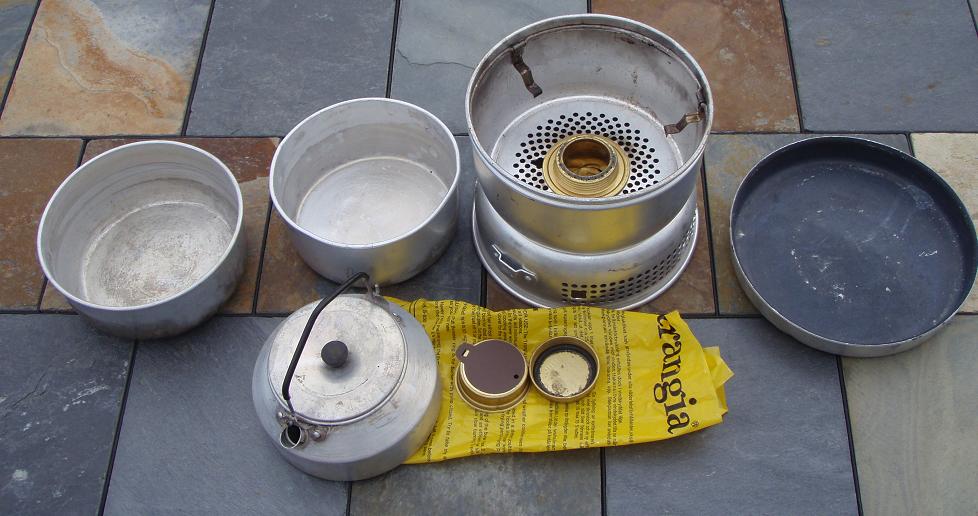
|
Trangia T-25 and Trangia T-27
T-25 is 44.2 ounces T-27 is 35.8 ounces
The two Trangia models, the T-25 and T-27 are identical, except that the windscreen
and pots for the T-25 are larger. The T-25 kit comes with 1.75 and 1.5 liter pots, a 0.9 liter tea kettle,
and a 22 cm frying pan. The T-27 kit comes with two 1 liter pots, a 0.6 liter tea kettle, and an 18 cm frying
pan.
This alcohol stove is an extremely simple affair consisting of a round cup-like
burner which fits inside a heavy duty two piece aluminum windscreen. The windscreen has high sides, and pots nest down inside
the windscreen, which protects the flame from wind, and also directs the heat up along the sides of the pot. With the frying
pan/lid over the cook pot, this stove is pretty much impervious to wind and rain. The alcohol burner is self pressurizing,
and after it has warmed up, flames shoot up out of small holes which are all around the circumference of the burner.
Limitations:
The Trangia is not ultralight. At about 2 pounds for the smaller kit, it is not for those
trips where you are counting ounces.
The Trangia doesn't put out nearly the heat of a white gas or butane cannister
stove, and boiling times are therefore longer than a white gas or butane stove. Typically, it takes between
10 and 15 minutes to bring 1 and a half liters of water to boil (a little less with the 1 liter pots.) If you are in
a hurry, this is not the stove for you. Alcohol has much lower heat output than either white gas or butane, so if you are
going on a long trip, you will have to carry significantly more fuel for the Trangia than you would for a white gas or butane
stove.
Control over heat output is limited. The Trangia really has only two settings,
full, and low simmer, with very little control compared to a modern white gas or butane stove. If you need to carefully control
the heat for some culinary masterpiece, the Trangia will not give you the control you need.
The fuel burner contains enough fuel for about a half hour of cooking. In
normal conditions, this will boil two large (1.75 liter) pots or three 1 liter pots of water. When the fuel
runs out, you have to refill the burner. Sometimes, it is difficult to tell when the fuel has run out, as the stove operates
virtually noiselessly. I have often been waiting for water to boil, wondering why it was taking so long, only to discover
that the fuel had run out.
Strengths:
The Trangia does have many good points, which make it my stove of choice more
often than not when I am going out for an overnight or week end trip.
The Trangia is utterly simple and completely reliable. There are no moving
parts and literally nothing to break. I've used and abused my Trangia since 1983 and it is still functioning just like it
did when it was new. To get the stove started, you simply unpack it, pour some alcohol in the burner, place the burner in
the windscreen, and light the alcohol in the burner. There is no priming, pumping, etc. Once lit, you don't need to tend the
stove, it just pretty much goes on cooking without the need for pumping, etc. Given the extremely quick set up and lighting,
it generally takes less time to get the first pot of water boiling with the Trangia than it does with a white gas stove.
I typically get the Trangia fired up, then go about setting up my camp, and by the time I'm finished putting up my tent and
laying out my sleeping bag, my water is boiling.
The Trangia is extremely quiet. It cooks without any noise at all, making
even a Whisperlight sound noisy. You can cook your dinner and listen to the sound of crickets, falling snow, or whatever else
you may hear.
As mentioned above, the Trangia is extremely weather proof. You can cook in
nasty weather, including hard winds, without problems.
Alcohol is a relatively safe fuel. There is no flare-up, and much less danger
than with white gas. The stove itself is extremely stable, and it is extremely difficult to tip over or spill a pot which
is cooking nested inside the wind screen. This is a good stove for klutzes or to use around kids.
Lastly, the stove, windscreen, and pots are extremely robust. Even Boy Scouts won't likely
break or damage the Trangia burner or components.
Overall, I really like the Trangia. For several years, it was the only stove
I owned, and I used it all four seasons, for everything from long backpacking trips, to overnighters, from snow melting to
warming up a kettle of water for hot chocolate. It has been supplanted by other stoves now for long trips, climbing, and snow
melting chores, but in situations where simplicity, weather-proofness, and reliability are more important than massive heat
output, it is hard to beat the Trangia. If I'm doing an overnighter with my kids, the Trangia is still the stove that
will most likely be in my pack.
| Trangia 27 and Trangia 25 |
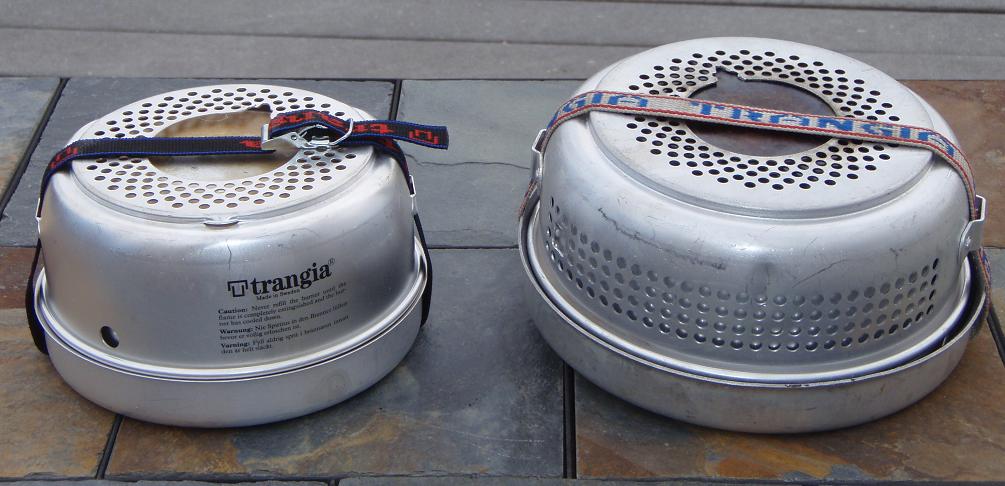
|
| These two cook sets are almost identical except for size of the cookware. |
Trangia Web Page
| Trail Designs Ti-Tri Alcohol / Wood-burning Stove |
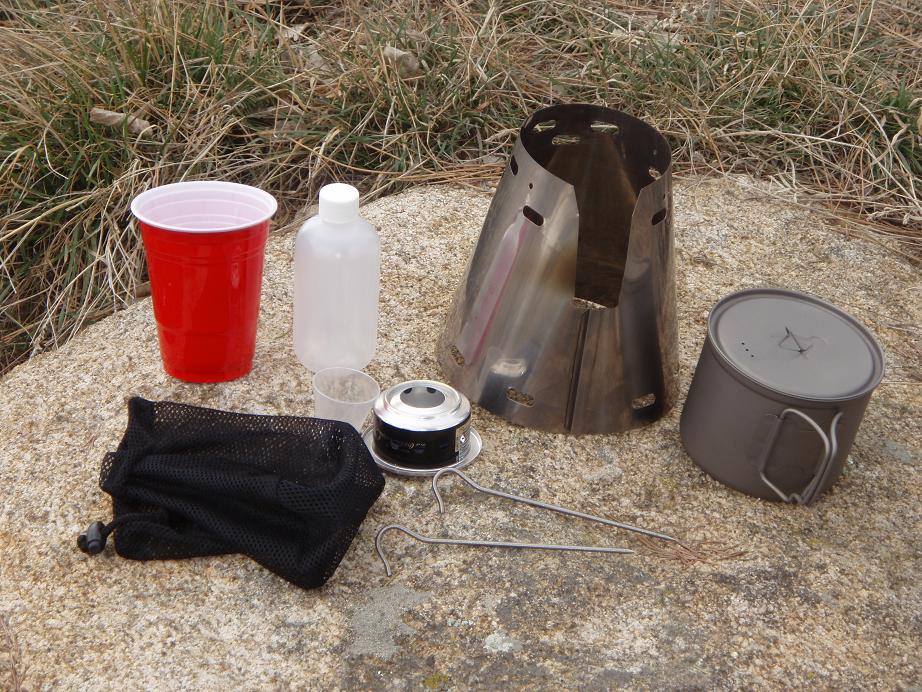
|
| 8.4 ounces for everything in the picture! |
Trail Designs/Titanium Goat Ti-Tri Stove
(8.4 ounces total weight for everything in the picture above, including the emptly fuel
bottle 0.9 liter pot, and carrying bag)
Although you won't find their gear at mainstream outdoor stores, the folks at Trail Designs make
some of the lightest, most innovative, and most functional stoves anywhere. Their stoves are simple and elegant, and
consist of a heavyweight springy, flexible metal sheet that is formed into a combination windscreen and pot support.
They call this the "Caldera Cone." The cone functions to support the pot, shield the burner from wind, and channel heat
to the pot rather than letting the heat disipate.
Each Caldera Cone is manufactured to fit a particular pot, and a wide variety Cones are available
to match many different lightweight pots from companies like Snowpeak, MSR, etc. The height of the cone varies with
the size of the pot, so that the system maintains an optimal distance from the burner for efficient heating.
The alcohol burner that accomanies the Caldera Cone is manufactured from an aluminum Coke can.
However, it's a very crisp and well done conversion, much better than that Coke can stove you probably constructed
at some point if you were ever in the Boy Scouts.
The advantages of the Caldera Cone are several: First of all, it's very very lightweight.
The entire system, including the pot and fuel bottle weighs 8.4 ounces. That's crazy light. However, a lightweight
stove isn't worth carrying if it doesn't work. This one does work. About an ounce of fuel will boil a liter of water
in from 12-15 minutes. That's not blazing fast, but it's not bad for an alcohol stove. Even better,
the boiling times are not affected very much by wind. I've not tried to cook in a gale, but moderately strong winds
don't phase the stove much at all.
The stove is simple and fool-proof to operate. No priming, no pumping, and the fuel is
not scary volatile like white gas.
This particular version of the Caldera Cone is called the Ti-Tri, and is a joint development
with the folks at Titanium Goat, another producer of niche outdoor gear. The Cone is made from titanium rather than
aluminum, and is therefore stronger and able to withstand higher temperatures. This means that you can use the
Cone with wood fires in addition to the alcohol stove burner.
The configuration in wood burning mode is almost the same as for alcohol, except that two titanium
tent stakes are inserted near the top of the cone to create a raised platform to support the pot. You can make the fire
first, then put the cone over the fire, or, in windy conditions, you can use the cone to provide a wind shield and build
the fire inside the cone. Once the fire is going strong, the protection of the cone reduces the chance of
burning sparks and embers escaping and catching the forest on fire.
Although you do get more soot and blackening when using fire, it's not really a big deal. The versatility that this gives you is really great. You can use the Ti-Tri as a wood burning stove when you
are in wooded areas, but if your trek takes you above timberline, or if a heavy bout of rain limits the availability of dry
wood, you can just use alcohol.
On a 9 day backpacking trip where I was using the Caldera Cone, I would typically use wood
for my dinner meal, when I had the time and the inclination to cook with fire. For breakfast, (when I'm typically
in a hurry to get on the trail or get out and fish) I used alcohol so I didn't have to mess around with building and
feeding a fire. I brought a couple of extra ounces of alcohol fuel that we used for dinner cooking on some nights
where we were just not interested in messing with a fire.
The Caldera Cone/Ti-Tri system is relatively fragile. The alcohol burner crushes easily,
and the cone can get bent and mashed if it is treated carelessly. I'm used to dropping my stove at the bottom of my
pack and then forgetting about it. You can't do that with this stove unless you protect it with something. The
burner will fit in the pot for protection, but the cone is a bit bulky. It will roll up inside of a plastic cup, but
this solution still is not bomb proof.
I tried a couple of solutions to contain and protect my Caldera cone stove, including various
large cups with screw on lids, etc. However, the folks at Caldera Cone have recognized this need and now have available
a tailor-made plastic cover to protect the stove when stowed. They call it the "Caldera Caddy." It consists
of a plastic, straight sided cylinder that is sized to fit the cone, fuel bottle, and burner. It unscrews into
two pieces that can be used as a bowl and cup. Total weight for the caddy is 3.1 ounces. It's a good solution
to the problem of protecting the cone and stove burner from damage. The 3 ounce weight is reasonable, particularly when
you consider that the caddy can take the place of a cup and bowl. With the Caddy, you can be less worried about
the need to protect the stove, as it protects it from typical backpacking bumps and abuse. (Just don't sit
on it.)
Once you start the fire, you can't easily move the stove, , you are burning your fire directly
on the ground, so some care is required in choosing the location for your stove prior to use. Also, and unless you are
utilizing the optional metal floor sheet, you are burning your fire on the bare ground, so you will leave a fire ring.
Also, while you can use frying pans and the like with the Caldera Cone, it really wasn't designed
for this, and you will likely lose some of the efficiency of the integrated system.
I would not choose the Caldera Cone Ti Tri system for snow melting duties. It just doesn't
have the heat out put necessary.
However, for lightweight, 3 season backpacking, this stove system is hard to beat. The
combination of weight, the ability to burn both alcohol and wood for fuel, and the reliability of the system make it a perfect
choice for long trips.
I liked my original .9 liter Ti-Tri so much, that I ordered a larger 1.4 liter version for
greater capacity.
I found that with the larger capacity pot, the alcohol burner that comes with the stove is perhaps
pushed a bit beyond its design capabilities. It struggles to bring a liter or more of cold water to a boil. I
solved this issue by replacing the Caldera Cone burner with my Trangia burner. Used with my Caldera Cone, the Trangia
burner was able to bring a liter of water to boil in 11 minutes, as opposed to the 24 minutes required for the stock burner.
The Trangia burner weighs a little more, but I think that the increased performance is worth it.
Trail Designs Web Site HERE
| Ti Tri Stove in Alcohol Burning Configuration |
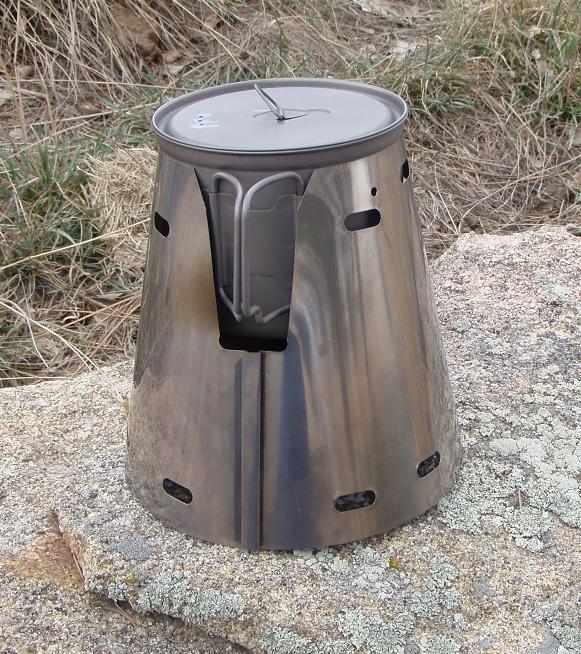
|
| Ti Tri Stove in Fire Burning Configuration |
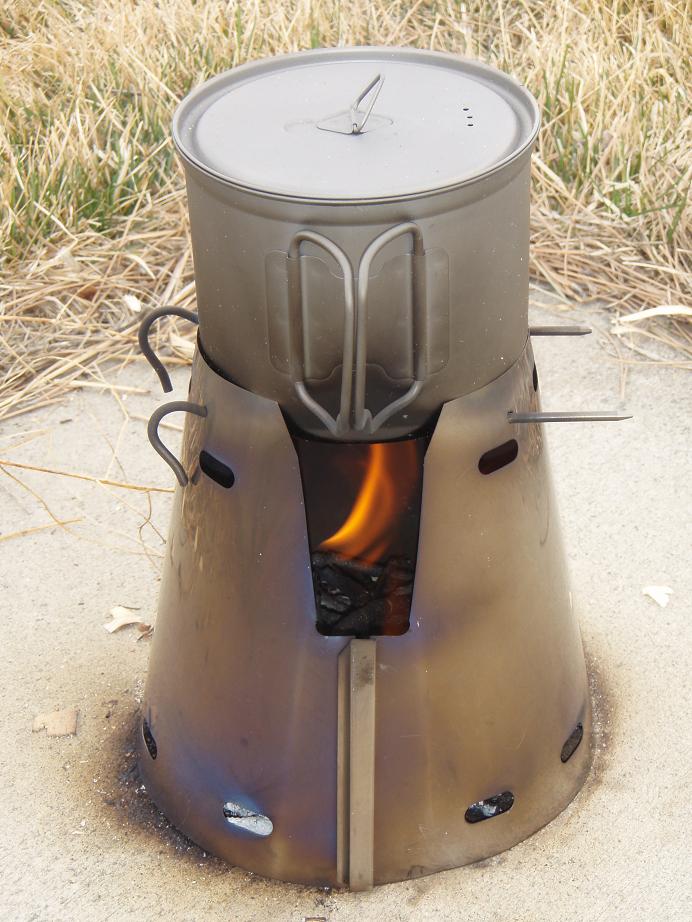
|
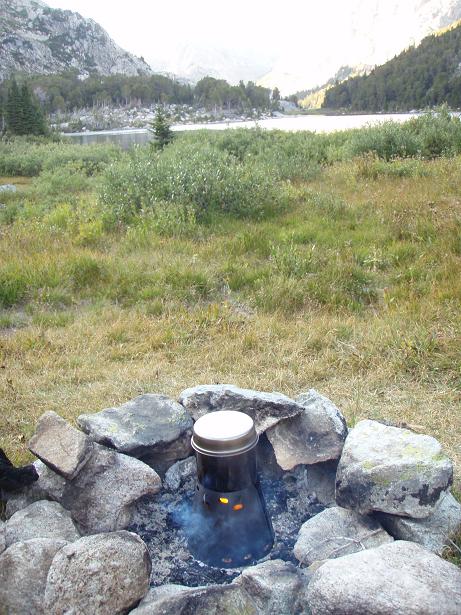
Bush Buddy Stove
(Stove is 6.4 ounces, 0.9 liter pot is 5.8 ounces)
| Bush Buddy Woodburning Stove |
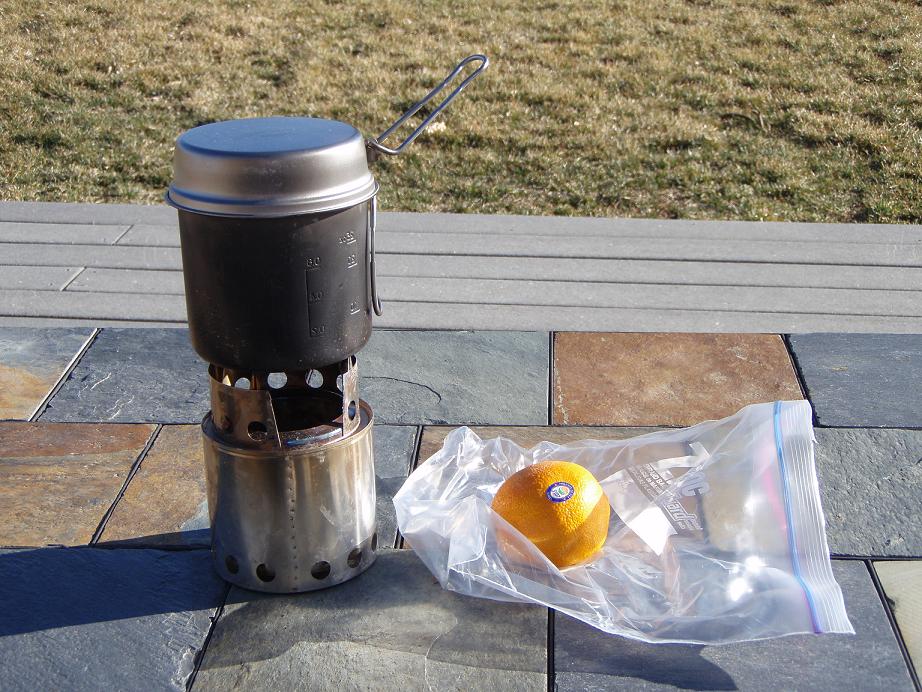
|
The Bush Buddy is a very lightweight woodburning stove.
It is designed to nest inside a 0.9 liter pot, which makes it very compact.
Although it is lightweight, it is quite sturdy, and is manufactured out of stainless steel. It will stand up to many
years of use and abuse without any problems.
Using the stove is pretty simple. You build a fire on the interior grate, then put the
pot on the elevated stove support. You can continue to feed sticks into the stove without removing the pot. The
double wall construction of the stove, and the fact that it is completely contained make it relatively easy to move the
stove, even after it is lit.
The stove's design uses the heat of the fire to create a draft that draws in additional air from
the stove base. This makes the fire burn a bit hotter and more efficiently than a simple open flame.
The advantages of this stove are pretty obvious. It weighs very little, is very compact,
and it uses natural fuels. It functions well, and the updraft feature does intensify the flame as advertised. In
addition, the pot support is compatible with other pots besides the 0.9 liter pot it is designed for, so you can use bigger
pots if you want, or a frying pan without any issues.
I have encountered some significant disadvantages, however. First off, the stove's
configuration makes it more difficult to lay and light a fire. You can lay a small fire inside the stove, on the
grate, however, the small confines of the stove make it difficult to light the tinder because you can not approach the tinder
from the bottom or side, you must light it from the top. This makes it quite a bit harder to start the fire, particularly
if you are using a lighter. I find it much easier to light a fire from the side or below.
| Fire grate on the Bush Buddy Stove |
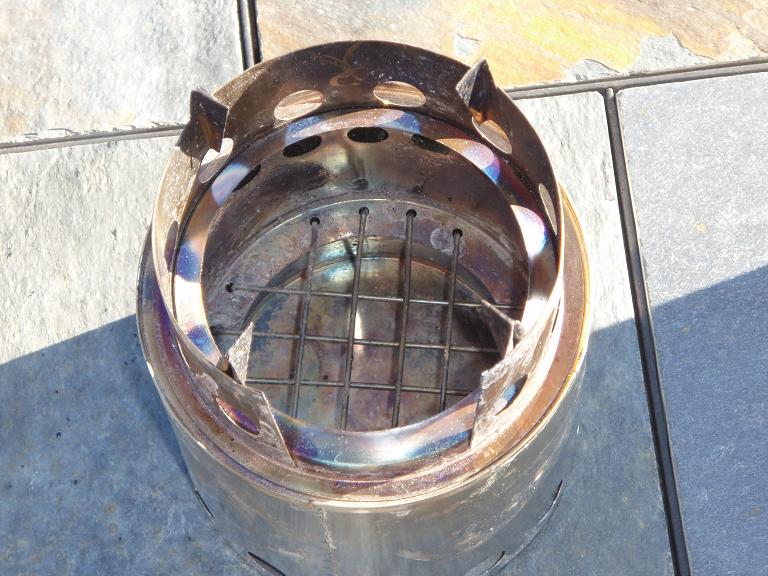
|
| Bush Buddy Stove packed inside the .9 liter pot |
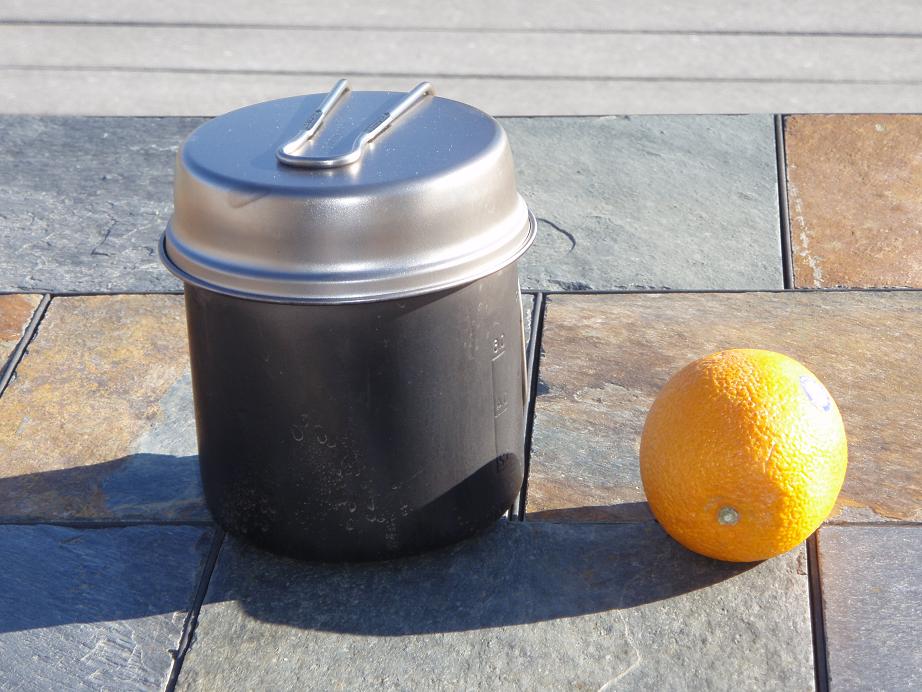
|
The other disadvantage I've found with the Bushbuddy stove is that it is
quite sensitive to wind. Without a windscreen, performance drops off dramatically. In a moderate breeze, the stove
will take a long long time to boil water unless you shield the flame from the wind. Once you add a windscreen, the problem
is solved, but the addition of the windscreen increases weight, and also makes it more difficult to feed sticks into the stove.
Lastly, it's not easy to get the stove cleaned out after use. You
can shake out the ash and the like, but it's a bit of a hassle.
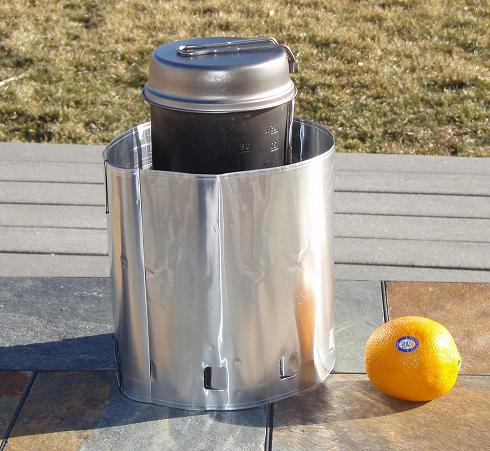
|
| I highly recommend using a windscreen with the Bush Buddy |
It might sound like I don't like the Bushbuddy stove. That's not true.
I used it and really liked it for a long time. I was won over by its quality construction, elegant design, light weight
and compact storage. For a while, this was my favorite lightweight backpacking stove. I put up with its problems
because its benefits were so attractive.
However, once I discovered and started using the Trail Designs Caldera Cone
systems, I found that I am using the Bushbuddy less and less. The Trail Designs system has an integrated windscreen
and performs better in breezy conditions, is lighter in weight, and is designed to burn alcohol. Also, the Trail
Designs system allows me to lay tinder and kindling for my fire, and then light the fire from the side. This makes starting
a fire much easier. So, I don't use th Bushbuddy much anymore. Not because it is a bad stove, but because
I simply like the Trail Designs Ti-Tri Caldera Cone better.
Bushbuddy Stove Web Site HERE
|

